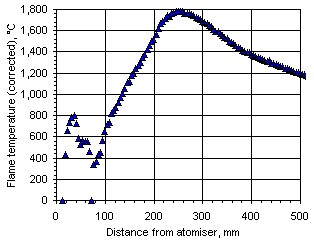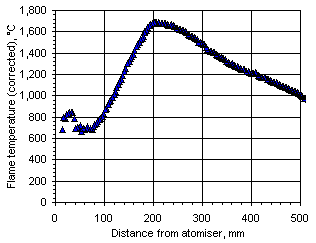3. Flame temperature profile
The similarity of the axial flame temperature from the diesel fuel compared to that obtained from the heavy gas oils used in this work is of great relevance. Comparable temperature traces in both flames would indicate the formation of similar amounts of thermal-NOX from the heavy gas oils, as thermal-NOX is mainly dependent upon flame temperature.
In order to assess this aspect of thermal-NOX formation, experiments were carried out to record the temperature profile of the flame produced by a diesel flame. The same experimental conditions as in experiments performed with the heavy coker gas oil M1 (see chapter V) were used. The equivalence ratio in this experiment was again 0.833, and the furnace wall temperature was 900 °C. Also the compensation of the temperatures recorded was performed according to the procedure reported in chapter V.
The experimental results of the flame temperature after corrections were applied can be seen in Figure 104. A graph showing the flame temperature profile obtained from the heavy coker gas oil M1 follows (see Figure 105).

Figure 104: Flame temperature profile from diesel fuel at  = 0.833 and 900 °C furnace wall temperature corrected for heat losses
= 0.833 and 900 °C furnace wall temperature corrected for heat losses

Figure 105: Flame temperature profile from fuel M1 at  = 0.833 and 900 °C furnace wall temperature corrected for heat losses
= 0.833 and 900 °C furnace wall temperature corrected for heat losses
Both graphs show similar shapes of the temperature profile. Large scatter exists in the initial spray zone of the flame. Subsequently, the flame temperature rises rapidly, although at a rate which is slightly lower than that of fuel M1 (8.7 °C/mm vs 9.5 °C/mm). At 200 mm from the atomiser nozzle the temperature of the diesel fuel flame was 1,521 °C, whereas fuel M1 had almost reached its maximum temperature (1,691 °C). The maximum flame temperature from diesel fuel (1,780 °C) was recorded at a longer distance, approximately 259 mm, from the atomiser nozzle. Subsequently the flame temperature remained higher than that from fuel M1 for the remainder of the combustion chamber, with exit temperatures well above those of fuel M1.
The peak flame temperature can be used as an indication of thermal-NOX formation. Comparison of both flame temperature profiles shows that lower amounts of thermal-NOX would be formed from the combustion of the heavy gas oils as their maximum temperature is lower than that from diesel fuel (1,691 °C vs 1,780 °C).
Also, the emission of total-NOX from the latter is 21.6 ppm-wet, which represents a conversion of fuel-N to NOX of 76 %. This may indicate that thermal-NOX formation is not relevant if compared to that from the nitrogen in the fuel.
Thus, it can be concluded that no appreciable amounts of thermal-NOX are formed in the drop-tube furnace at the furnace wall temperature of 900 °C.
Pollutant formation and interaction in the combustion of heavy liquid fuels
Luis Javier Molero de Blas, PhD thesis, University of London, 1998
© Luis Javier Molero de Blas

 = 0.833 and 900 °C furnace wall temperature corrected for heat losses
= 0.833 and 900 °C furnace wall temperature corrected for heat losses

 = 0.833 and 900 °C furnace wall temperature corrected for heat losses
= 0.833 and 900 °C furnace wall temperature corrected for heat losses

